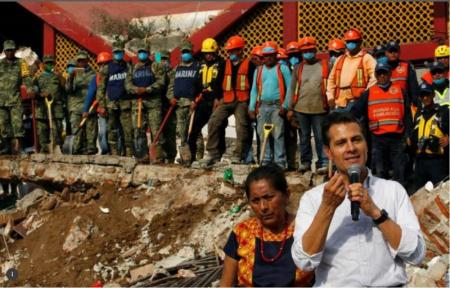
Mexico's President Enrique Pena Nieto addresses residents after an earthquake struck off the southern coast of Mexico in Juchitan, Mexico, September 8, 2017. (Photo: REUTERS/Jorge Luis Plata)
By Robert Glasser, UN Secretary-General's Special Representative for Disaster Risk Reduction
Geneva, 14 September 2017 - Mexico has been working to improve its early warning systems and disaster risk management for over three decades.
There are few countries in the world resilient enough to respond to a hurricane and the strongest earthquake in a century, accompanied by a tsunami threat, all within hours of each other. Such was the challenge that confronted Mexico last week.
Last Thursday, officials at Mexico’s National Civil Protection System, created after the 1985 earthquake that claimed over 10,000 lives, were keeping a watchful eye on Hurricane Katia, one of three hurricanes newly emerged from the Atlantic, when the country was hit by an 8.1 earthquake which triggered 3-metre waves along parts of the Pacific coastline.
Tragically, some 90 people lost their lives in the states of Chiapas, Oaxaca and Tabasco, and many have been made homeless notably in the destroyed town of Juchitan. But the numbers of affected could have been higher if not for the continuous improvement of Mexico’s early warning systems and disaster risk management for all natural hazards, which has been ongoing for over three decades.
The 8.1 earthquake rippled across Mexico City for a full minute before subsiding, but the “alerta sismica” (seismic alert) gave residents a vital 86 seconds to find safety before it struck. The epicentre was further from the city than the 1985 earthquake, but the consequences could have been deadly without the measures taken over the last 32 years.
Two years ago this month saw the activation of a new Seismic Warning System operated through 8,200 loudspeakers, to familiarise residents of Mexico City with the sound of alerts that give them up to 50 seconds’ notice of earthquakes. The alerts are also sent to mobile phones and other devices. To mark the 30th anniversary of the 1985 earthquake, Mexico City and the federal government cooperated on a national earthquake simulation, involving some 80,000 public employees, 26 government agencies and the federal police.
The benefits of such actions - along with steady progress on relocating vulnerable populations, strengthening building codes and planning land use - are incalculable in terms of saving lives and reducing damage to critical infrastructure and economic losses.
Mexico’s President Enrique Peña Nieto has been at the forefront in demonstrating his political commitment to reducing disaster risk in both mainstream and social media. This was evident during Hurricane Patricia, the strongest hurricane ever to make landfall on Mexico’s Pacific coast two years ago - and again during these latest disasters.